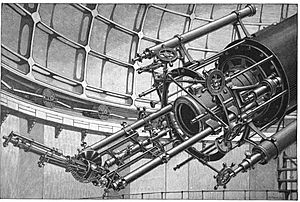Astronomical spectroscopy facts for kids

Astronomical spectroscopy is a cool science that helps us understand what things in space are made of. Imagine using a special tool called a spectroscope to look at stars, planets, and nebulae. This tool helps scientists figure out their chemical ingredients. It can also show how these space objects are moving, using something called the Doppler shift.
Scientists use the study of spectroscopy and spectra (which are like light fingerprints) to learn about all kinds of light coming from space. This includes the light we can see, and other types of electromagnetic radiation that stars and other hot objects give off. By studying these light fingerprints, we can find out many things about distant stars and galaxies. We can discover their chemical makeup, how hot they are, how dense they are, their mass, how far away they are, how bright they shine, and even how fast they are moving towards or away from us.
Contents
Unlocking the Secrets of Starlight
Have you ever wondered what stars are made of? Astronomical spectroscopy helps us find out! It's like a detective tool for light.
How Light Reveals Star Ingredients
Long ago, a famous scientist named Newton used a prism to split white light into a rainbow of colors. Later, another scientist named Fraunhofer used even better prisms. He noticed strange dark lines in the rainbow of light from the Sun. No one knew what these lines were at first.
It wasn't until the 1850s that two scientists, Gustav Kirchhoff and Robert Bunsen, explained these mysterious dark lines. They discovered a few important things about light:
- Hot, solid objects (like a light bulb filament) produce light with a full, unbroken rainbow of colors. This is called a continuous spectrum.
- Hot gases, however, give off light only at very specific colors or wavelengths. This creates bright, colorful lines, known as an emission spectrum.
- When light from a hot, solid object passes through a cooler gas, the gas absorbs some of the light. This creates dark lines in the continuous spectrum. These dark lines appear exactly where the hot gas would normally emit bright lines. This is called an absorption spectrum.
By comparing the dark absorption lines from the Sun's light with the bright emission lines of gases we know on Earth, scientists can figure out what chemicals are present in stars. It's like matching fingerprints to solve a cosmic mystery!
Images for kids
See also
 In Spanish: Espectroscopia astronómica para niños
In Spanish: Espectroscopia astronómica para niños




